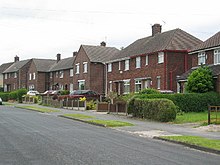Right to Buy
By 1997, over 1,700,000 dwellings in the UK had been sold under the scheme since its introduction in 1980, with the scheme being cited as one of the major factors in the drastic reduction in the amount of social housing in the UK, which has fallen from nearly 6.5 million units in 1979 to roughly 2 million units in 2017, while also being credited as the main driver of the 15% rise in home ownership, which rose from 55% of householders in 1979 to a peak of 71% in 2003; this figure has declined in England since the late 2000s to 63% in 2017.The Labour Party initially proposed the idea of the right of tenants to own the house they live in, in their manifesto for the 1959 general election, which they lost.He said the right to buy had two main objectives: to give people what they wanted and to reverse the trend of ever-increasing dominance of the state over the life of the individual.[17] Sales were restricted to general-needs housing; adapted properties and those built specifically for older people were exempted from the scheme.The effect was to reduce the council housing stock, especially in areas where property prices were high, such as London and the south-east of England.[19] The Labour Party was initially against the sales and pledged to oppose them at the 1983 general election but dropped its official opposition to the scheme in 1985.[21] When Labour returned to power at the 1997 general election, it reduced the discount available to tenants in local authorities which had severe pressure on their housing stock; this included almost the whole of London.Five years' tenancy was now required for new tenants to qualify, and properties purchased after January 2005 could no longer immediately be placed on the open market should the owner decide to sell.In 2009, the Localis think tank suggested, as part of a review of principles for social housing reform, that the right to buy should be extended into equity slivers, which could be part-earned through being a good tenant.
Scotlandsecure tenantscouncilshousing associationslegal rightassured tenantssocial housing in the UKMinister of State for HousinggentrificationWeaverhamcouncil housesLabour Party1959 general electionMargaret ThatcherBibliographyElectoral historyHonoursMP for FinchleyPublic Bodies (Admission to Meetings) ActCircular 10/70Shadow Cabinet1975 leadership election1979 VoNC in Callaghan ministryPremiershipThatcherismMinisterswets and driesFirst ministry1979 election"The lady's not for turning""TINA"1979 budget1980 budget1981 budget1982 budget1983 budgetFalklands WarSecond ministry1983 re-election1984 budget1985 budget1986 budget1987 budgetAnglo-Irish AgreementBig BangBrighton bombingJoint DeclarationMiners' strikeUK rebateWestland affairThird ministry1987 re-election1988 budget1989 budget1989 leadership election1990 budget1990 leadership election and resignationBruges speechPoll taxSermon on the MoundCeremonial funeralThe Downing Street Years (1993)The Path to Power (1995)Prime MinisterHousing Act 1980Michael Heseltineinner Londonnorthern England1987 general election1997 general electionFinancial Conduct AuthorityLocalisConservative Party ConferenceDavid CameronHousing and Planning Bill 2016Scottish GovernmentHousing (Scotland) Act 2014Welsh GovernmentWelsh AssemblyLondon AssemblyTom CopleyIan GowHelp to BuyThe Housing QuestionPolly ToynbeeSaatchi & SaatchiJoseph Rowntree FoundationGOV.UKWayback MachineOffice of the Deputy Prime MinisterHousing in the United KingdomHousing in ScotlandHousing in WalesVictorianEdwardianGlasgowLiverpoolAffordabilityEnergy efficiencyHomelessnessAct 2002EnglandGatekeepingReduction Bill 2016–17Homes EnglandHousing CorporationPublic HousingSlum clearanceSquattingBack-to-backBirmingham Back to BacksEnglish countryEstatePrefabricatedAtholl steelReema constructionWimpey no-finesTerracedByelawPre-regulationTwo-up two-downTower blocksTownhouseWeavers' cottageWealden hallGrants, Construction and Regeneration